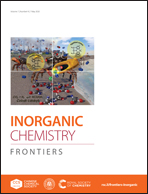Constructing heterostructured FeS2/CuS nanospheres as high rate performance lithium ion battery anodes†
Abstract
Iron sulfides have been considered as a promising anode material in recent years, characterized by higher theoretical capacities, non-toxicity, and abundant reserves in nature. Nevertheless, they suffer from large volume changes during cycling and severe irreversible capacity loss because of their weak electronic conductivity as well as poor stability. In this work, heterostructured FeS2/CuS nanospheres (HFCSs) are successfully synthesized by a facile hydrothermal method and vapor phase vulcanization at mild temperature. The copper ions are uniformly distributed in the HFCS composites, endowing them with continuously high conductivity during the constant electrochemical process. When applied to lithium ion batteries, the composites exhibit impressive electrochemical performance. As expected, the assembled HFCS electrodes possess a high reversible capacity of 843.3 mA h g−1 even after 600 cycles at 1.0 A g−1 and a surprising rate capability of 530.4 mA h g−1 at 10.0 A g−1, which are superior to those of most of the reported FeS2 or CuS anode materials. The assembled HFCS electrodes possess both high conductivity and a porous structure, which is beneficial to the interior electron transport, reaction kinetics, lower volume changes and pulverization, significantly achieving improved rate capability as well as remarkable long-term cycling stability. This approach is feasible for fabricating heterogeneous porous structures and may shed some light on designing metal sulfide-based anode materials with high rate performance for energy storage applications.



 Please wait while we load your content...
Please wait while we load your content...